Exercise Routines Esports: Boost Your Gaming Skills and Wellbeing
Updated On: October 24, 2025 by Aaron Connolly
The Importance of Exercise in Esports
Physical fitness shapes how you play. It sharpens reaction times, keeps you focused, and helps you last through those marathon matches.
Esports athletes who stick with exercise routines notice better brainpower and fewer injuries from long hours at their setups.
Impact on Competitive Performance
Exercise boosts the skills that really set top gamers apart. Cardio workouts, for example, speed up your reaction time and help you make smarter decisions.
That can be the difference when a split-second call decides a match.
Cognitive benefits include:
- Faster reactions in clutch moments
- Better focus during endless tournament matches
- Improved memory for game plans and patterns
- Sharper problem-solving when things get stressful
A lot of pros train about 30-40 minutes per session, two or three times a week. Teams like EXCEL ESPORTS even schedule regular cardio right alongside their gaming practice.
Players who keep up with fitness routines say they make fewer mistakes in long matches.
Exercise pumps more blood to your brain, which keeps you alert. It’s a game changer when you need to avoid mental slip-ups late in a competition.
Physical and Mental Demands
Competitive gaming really takes a toll on both your body and mind. Esports players often grind for 8-11 hours a day, which leads to some physical issues you might not expect.
Common physical problems include:
- Back pain from sitting too long
- Neck strain from staring at screens
- Wrist and hand injuries from repeating the same moves
- Poor posture that weakens your muscles
Mental health challenges can hit just as hard. Tournament nerves, streaming, and endless practice pile on stress fast.
Many players battle anxiety and burnout.
Gaming sessions demand laser focus for hours, with barely any breaks. Unlike traditional athletes, esports pros keep their brains switched on the whole time.
This constant mental load wears you out faster than you’d think.
Benefits for Esports Athletes
Regular exercise tackles both the physical and mental hurdles that gamers face. Cardio knocks down stress and builds the endurance you need for tournaments.
Key fitness benefits:
| Exercise Type | Gaming Benefit | Recommended Frequency |
|---|---|---|
| Stretching | Prevents injuries, improves posture | Daily (15-20 minutes) |
| Cardio | Better concentration, stress relief | 2-3 times weekly |
| Resistance training | Stronger core, injury prevention | 2 times weekly |
Stretching routines target those trouble spots—wrists, neck, and back. A few simple stretches each day can save you from the aches that push some players into early retirement.
Resistance training builds up your core, helping you sit with better posture.
Exercise also releases endorphins, which lift your mood and keep anxiety in check. That boost makes it easier to handle tournament pressure and stay confident during tough matches.
A lot of players notice they sleep better when they stick with exercise, and that good sleep pays off the next day.
Fundamentals of Esports Fitness
Esports fitness really comes down to three things: structured exercise routines, a focus on the fitness areas that help your game, and realistic goals that keep you going for the long haul.
Building an Exercise Routine
Start by looking at your current gaming schedule. Most players spend 8-12 hours a day in practice.
If you’re just starting out, try 30 minutes of physical activity every other day.
Your Weekly Exercise Framework:
- Monday/Wednesday/Friday: 20-minute cardio
- Tuesday/Thursday: 15-minute strength training
- Saturday: 30 minutes of stretching and flexibility work
- Sunday: Rest or light activity
Kick off each session with 5 minutes of gentle movement. That little warm-up helps your body shift from sitting to moving.
A lot of gamers find that morning workouts fit best, before practice eats up the day.
Start small. Maybe you just walk for 15 minutes the first week. By week four, you might be cycling for 30 minutes.
Quick Win: Set a phone reminder every two hours while gaming. Take two minutes to stretch at your desk.
Focus on showing up, not pushing hard at first. If you miss a day, don’t stress. But if you skip three in a row, it’s time to reset.
Key Fitness Components
Esports fitness zeroes in on four areas: cardiovascular endurance, muscle strength, flexibility, and mental resilience built through physical activity.
Cardiovascular Endurance boosts blood flow to your brain. This helps you stay sharp during those long matches.
Aim for 20-30 minutes of moderate cardio two or three times a week.
Strength Training targets your core, shoulders, and wrists. A strong core means better posture for hours of gaming.
Try:
- Planks and wall sits for your core
- Push-ups for shoulders
- Wrist stretches to avoid injuries
Flexibility Work keeps you from stiffening up. Ten minutes of stretching for your neck, back, and wrists every day can make a real difference.
Mental Benefits come from exercise too. Lower stress and faster reaction times? That’s a win.
Goal Setting for Gamers
Set goals that help your esports dreams, not hurt them. Your workouts should boost your gaming, not tire you out before practice.
Short-term Goals (4-6 weeks):
- Stretch for 10 minutes every morning, 15 days straight
- Walk 20 minutes without feeling wiped
- Hold a plank for a full minute
Medium-term Goals (3-4 months):
- Get comfortable with 30-minute cardio sessions
- Finish a full bodyweight strength circuit
- Play for 4+ hours without your back hurting
Performance-Based Goals: Tie your fitness gains to your gaming. Does your aim get better when you sit straighter? Does cardio help you focus longer in tournaments?
Warning: Don’t chase extreme fitness goals that steal time from practice. The best esports pros balance their workouts with 6-8 hours of gaming a day.
Try the “2% rule”—just get a little better each week. Maybe hold your plank 30 seconds longer or walk an extra minute.
Types of Exercises for Esports Players
Pro gamers really need three kinds of physical activity to stay at the top. Strength training keeps posture problems in check, and cardio helps you focus and keep your energy up during matches.
Strength and Conditioning
A lot of pros deal with back pain and tight shoulders from sitting so much. Strength training helps by building up the muscles you need for good posture.
Focus on your core. Strong abs and back muscles keep your spine straight through those long sessions.
Wall sits work well—hold for a minute or two, and repeat three times.
Push-ups and planks hit your upper body. These moves strengthen shoulders and chest, which get weak from leaning toward your screen.
Do three sets of as many reps as you can manage.
Don’t ignore your legs. Split squats and hip exercises keep them strong, and weak legs can mess with your stability at your desk.
Try 10-12 reps per set.
Your wrists and hands need care too. Use your opposite hand for simple resistance moves to avoid repetitive strain injuries.
Ten seconds per hand, every day, gets the job done.
Cardiovascular Training
Cardio helps your gaming directly. If your heart’s healthy, your brain gets more oxygen, and you stay sharp when it matters.
Try two or three cardio sessions a week, each about 45 minutes. You might run for 15, walk for 15, and run again for 15.
Cycling works if running feels too heavy on your joints. A 45-minute bike ride gives you the same boost.
Team sports like football or basketball make things social and fun. Many pro teams use them to build teamwork and get some fresh air after hours of gaming inside.
Your endurance will build up over time. Most people can’t do 30 minutes straight at first, so start small and work up.
Flexibility and Mobility
Stretch every day to avoid injuries that can end your career early. Your neck, back, and wrists take a beating when you game for hours.
Back stretches are key. Try the back-to-heel stretch—ten reps, hold each for five seconds. Bridges help too—hold for three seconds, repeat ten times.
Stretch your neck side-to-side and rotate gently. Hold each stretch for five seconds to ease the tension from staring at screens.
Do ten reps each way.
Wrist stretches protect you from carpal tunnel. Stretch each hand for ten seconds, then do resistance presses.
Repeat three times per hand.
Foam rolling helps your whole body recover. Roll out your core muscle groups after workouts to cut down on soreness.
Most stretching routines only take 15-20 minutes a day. That’s a small price to pay to avoid injuries that could stall your progress.
Enhancing Reaction Time and Reflexes
Quick reactions really set apart the pros—elite players react 30-40% faster than casual gamers. Hand-eye coordination drills and aim trainers can help you close that gap if you practice them regularly.
Hand-Eye Coordination Drills
Physical exercises build up the connection between your eyes and hands. These drills make a noticeable difference in your gameplay.
Jump rope is surprisingly effective. Start with 30-second intervals, three times a week.
The rhythm and timing are a lot like the precise moves you need in esports.
Table tennis is another great option. Even 15 minutes a day helps you track fast-moving objects.
Plenty of pros use this as a warm-up.
Try reaction ball drills with a rubber ball that bounces unpredictably. Drop it against a wall and try to catch it as it rebounds. It trains your eyes to spot sudden movement.
Juggling helps both hands work together. Start with two balls, then move up to three.
Ten minutes a session is plenty.
| Exercise | Duration | Frequency | Primary Benefit |
|---|---|---|---|
| Jump rope | 30 seconds | 3x/week | Rhythm and timing |
| Table tennis | 15 minutes | Daily | Object tracking |
| Reaction ball | 5 minutes | 4x/week | Unpredictable responses |
| Juggling | 10 minutes | Daily | Hand coordination |
Aim Trainers and Reflex Workouts
Digital training tools let you actually see your reaction time improve. These platforms track your progress down to the millisecond.
Aim Lab has free reaction time tests and reflex scenarios. Try the “Reflexshot” mode for pure reaction training.
Aim for 15-20 minute sessions to stay sharp without burning out.
Kovaak’s gives you more advanced drills. The “1Wall6Targets” scenario builds both reaction time and target switching.
A lot of pros spend about 30 minutes a day on these.
Human Benchmark gives you a baseline for your reaction time. Test yourself once a week to see how you’re improving.
Most people fall between 200-300 milliseconds.
Set up a consistent training schedule. Mornings usually work best since your mind is fresh.
Track your average times in a simple spreadsheet.
Warning: Don’t overdo it. Training for more than 45 minutes can actually make you slower and leave you mentally wiped.
Most aim trainers let you adjust the difficulty. Start easy, then ramp up the speed as you get better.
Ergonomics and Posture for Gamers
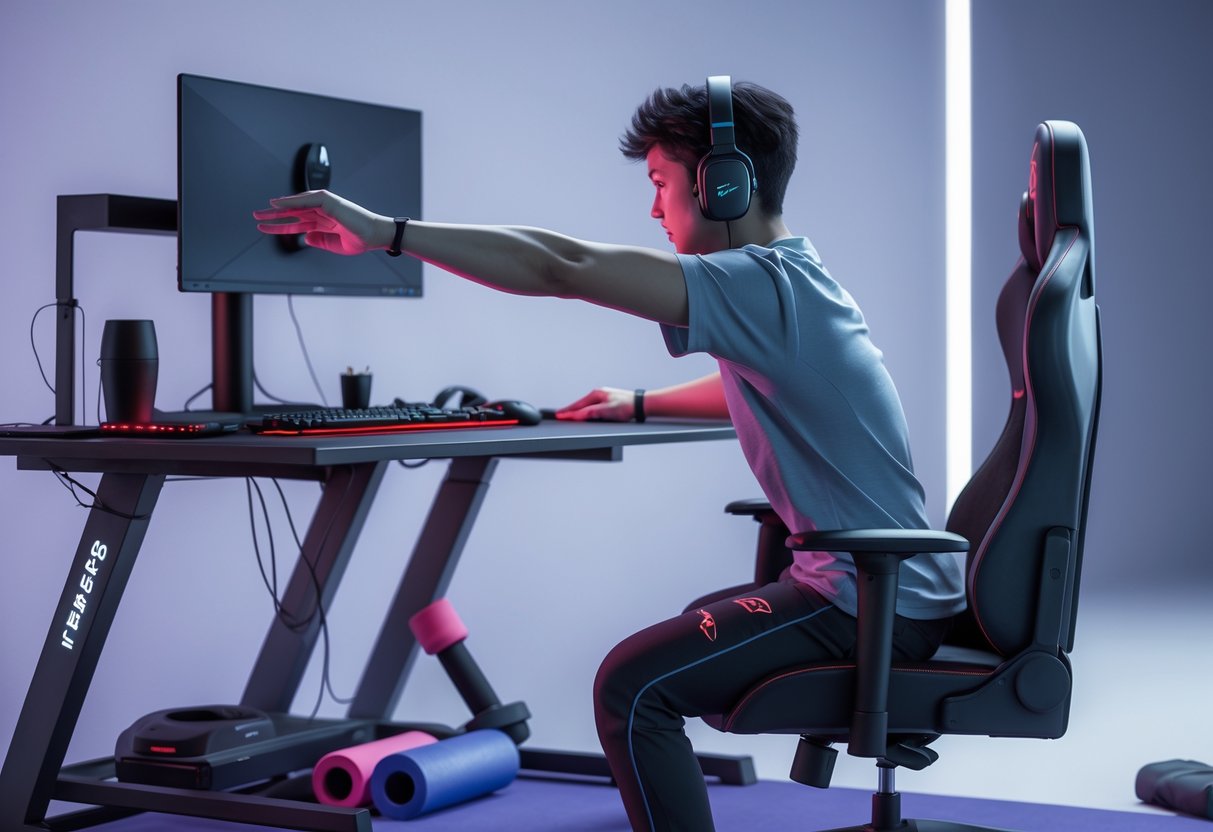
Let’s be real—bad posture can mess you up. Gamers often deal with carpal tunnel and back pain, but you can dodge most of it with smart ergonomics and a solid workspace setup. Plus, a few targeted stretches go a long way if you want to play for hours without feeling wrecked.
Setting Up Your Space
Keep your monitor at eye level. That way, your neck won’t ache after a long session.
Move the screen back—about 60cm works for most people.
Pick a chair with decent lumbar support. Your lower back will thank you.
Make sure your feet sit flat on the floor and your knees stay at a 90-degree angle.
Essential Setup Guidelines:
- Keyboard height: Keep elbows at 90 degrees, wrists straight
- Mouse position: Level with your keyboard, close enough so you’re not reaching
- Lighting: Don’t let windows or lamps glare up your screen
Your desk should let your arms rest easily. If it’s too high, try an adjustable keyboard tray.
Keep your stuff—water, snacks, gear—close. You shouldn’t have to stretch or twist every time you want something.
Stand up and move for five minutes every hour. It’s easy to forget, but this habit seriously cuts down your injury risk.
Posture Improvement Exercises
Try some simple neck and shoulder stretches. Rolling your shoulders backward ten times every hour can help undo that hunched-over gamer pose.
Don’t forget your eyes. The 20-20-20 rule means every 20 minutes, look at something 20 feet away for 20 seconds. It’s a tiny thing, but it helps more than you’d think.
Your wrists need attention too. For carpal tunnel prevention:
- Make fists and rotate your wrists ten times both ways
- Stretch your fingers out, then make a fist
- Gently pull your fingers back toward your wrist
A strong core means better posture. Planks or wall sits during breaks are surprisingly effective.
Stretch those hip flexors—just step into a lunge and hold for 30 seconds per side. Sitting all day tightens them up.
Set reminders on your phone for these exercises. You don’t need to go hard; just keep at it. Consistency beats intensity for good ergonomics.
Preventing and Managing Injuries
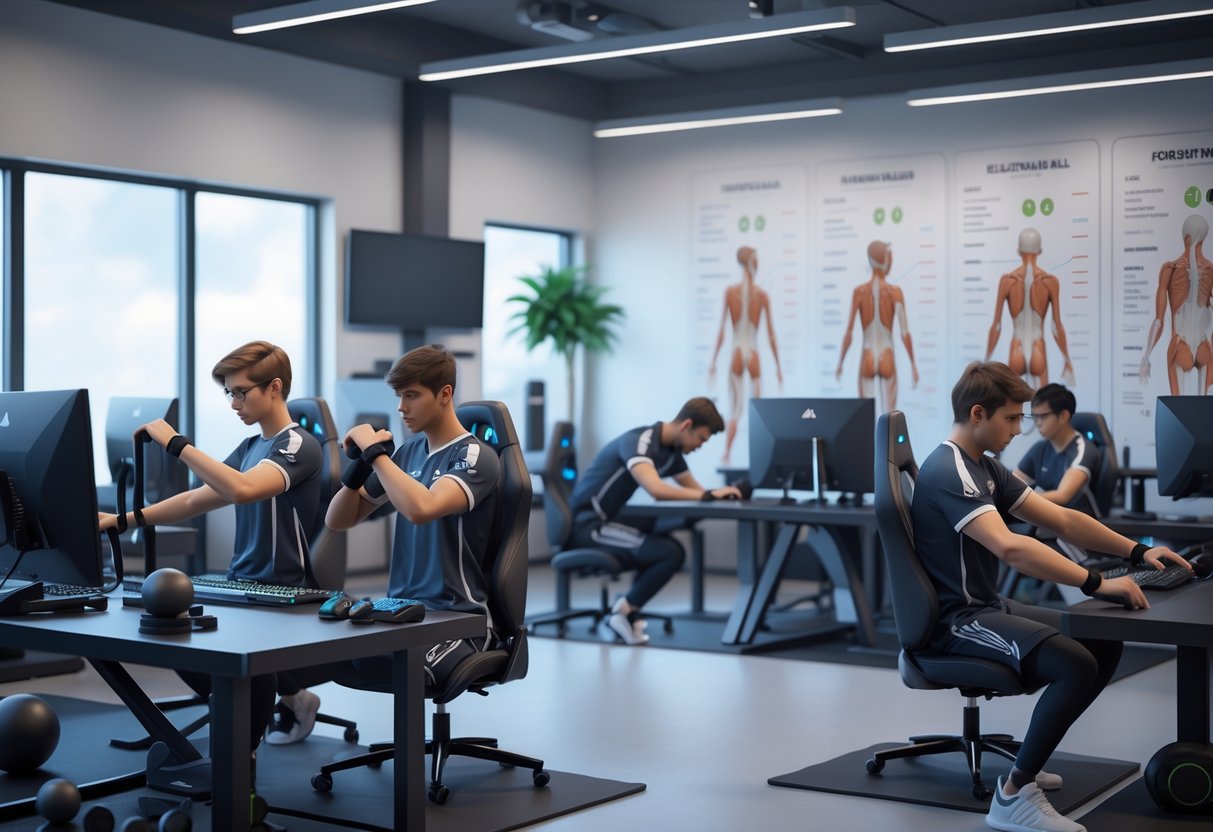
Long gaming sessions hit your body in weird ways—wrist strain, mental fatigue, you name it. If you play smart and look after your hands, you’ll stick around longer and play better.
Wrist and Hand Health
Repetitive strain injuries hit esports players all the time. Hours of clicking and tapping can lead to carpal tunnel syndrome and other nasty issues.
Before every practice session, warm up your fingers. Finger extensor bands work great for this:
- Finger separation: Band around four fingertips, spread them wide 15 times
- Thumb extension: Band around thumb and index finger, spread as wide as you can 15 times
- Full hand opening: Band around all fingertips, open your hand fully 15 times
Try some simple wrist resistance moves. Rest your forearm on a table, let your hand hang off, and curl your wrist up and down with a light weight—15 reps each way.
Take a 5-minute break every 30 minutes. Stretch your wrists, extend them all the way, and rotate gently in circles. It keeps your hands loose.
If you feel tingling or sharp pain in your fingers or wrist, stop right away.
Reducing Burnout and Fatigue
Burnout hits hard—and not just physically. If you push through endless practice sessions without breaks, your reaction times and decisions start to slip.
Keep intense practice to 4-6 hours a day with regular breaks. Most pros split it into 2-hour blocks and rest for 30 minutes between.
Stick to a solid sleep schedule. Shoot for 7-8 hours a night and try not to game right before bed. That blue light can mess with your sleep more than you’d think.
Move your body outside of gaming. Even a quick 20-minute walk cuts stress and clears your head. Lots of pro teams add gym time to their routine these days.
Set your phone to remind you every 45 minutes—stand up, stretch, and rest your eyes for a couple minutes. It’s a small thing that adds up.
Nutrition and Diet for Esports Performance
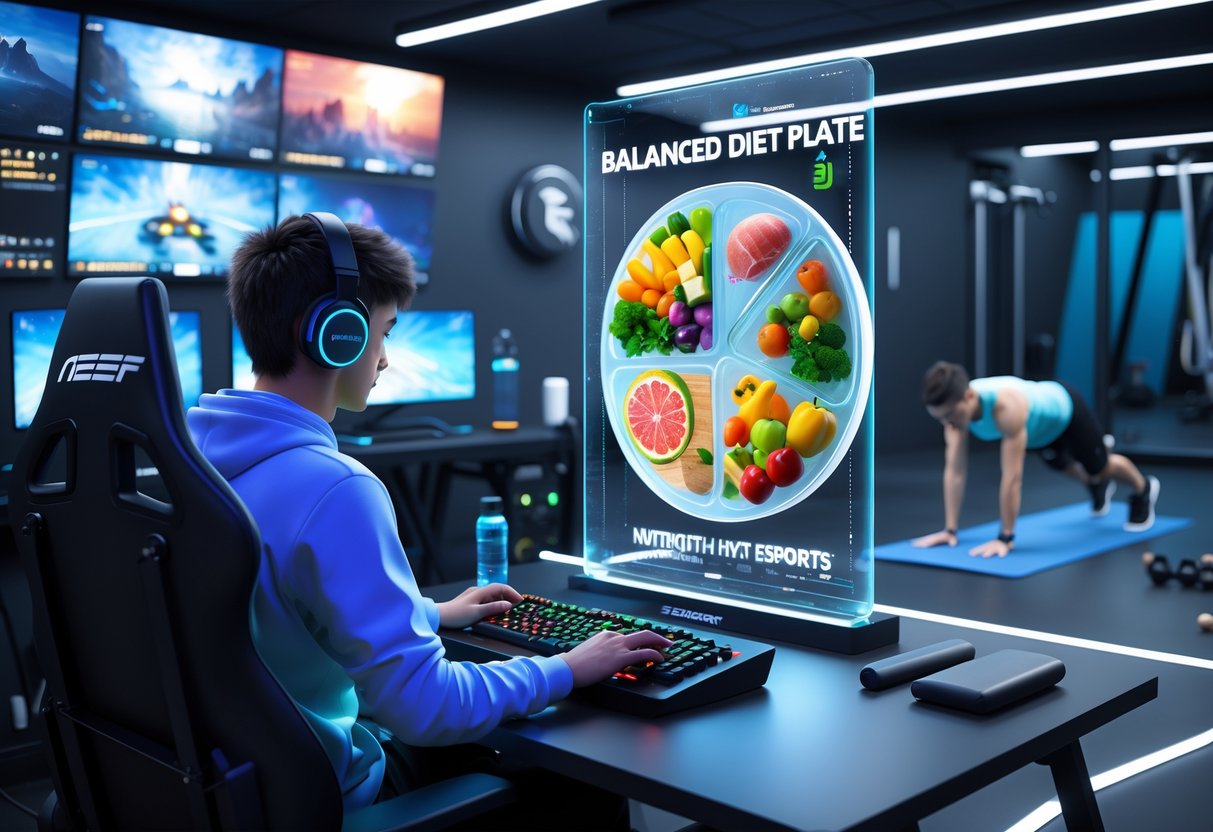
What you eat changes the way you play—seriously. Good nutrition boosts your reaction time, focus, and mental stamina. If you time your meals and pick balanced foods, you’ll feel sharper in long practice sessions and tournaments.
Balanced Diet Basics
Your brain needs steady fuel to work right. Complex carbs like brown rice, oats, and wholemeal bread give you energy that lasts—no sugar crashes here.
Protein keeps your focus from drifting. Go for chicken, salmon, eggs, or plant-based picks like beans and lentils. They help your brain stay sharp by building neurotransmitters.
Essential nutrients for gamers:
- Omega-3 fatty acids (salmon, walnuts) support brain health
- B vitamins (whole grains, leafy greens) help your body use energy
- Magnesium (nuts, seeds) reduces stress
- Zinc (meat, dairy) helps with focus and memory
Try building meals around these food groups. Some esports teams even hire nutritionists because they know how much diet matters.
Here’s a quick tip: Swap energy drinks for isotonic drinks with water. You’ll avoid those nasty sugar crashes during matches.
Fruit and Vegetable Intake
Fruits and veggies pack antioxidants that help your brain recover after intense gaming. Blueberries are awesome for memory and focus.
Dark leafy greens—think spinach and kale—give you folate and vitamin K. Both help your brain stay clear and focused during tough tournaments.
Easy, gamer-friendly snacks:
- Berries (grab a handful between rounds)
- Nuts and seeds (protein you can stash anywhere)
- Carrots and hummus (good crunch, no loud wrappers)
- Bananas (quick energy, no mess)
Keep prepped fruits and veggies handy in your gaming space. Pro teams often make snack boxes for training days.
One heads-up: Skip messy fruits near your setup. Sticky keyboards are a nightmare.
Timing Meals with Practice
Meal timing matters just as much as what’s on your plate. Big meals right before gaming can leave you sleepy and slow.
Eat your main meal 2-3 hours before big matches or heavy practice. That gives your body time to digest and keeps your blood sugar steady.
Match day meal schedule:
- 3 hours before: Full meal with protein and complex carbs
- 1-2 hours before: Light snack—nuts or fruit work well
- During breaks: Small bites to keep your energy up
- After matches: Eat a proper meal to recover
Teams like Excel Esports eat dinner 2.5 hours before matches. They swear it stops that “food coma” feeling.
For marathon sessions, grab small snacks every 2-3 hours. Don’t wait until you’re starving—steady fuel keeps you sharp.
Sleep and Recovery Strategies
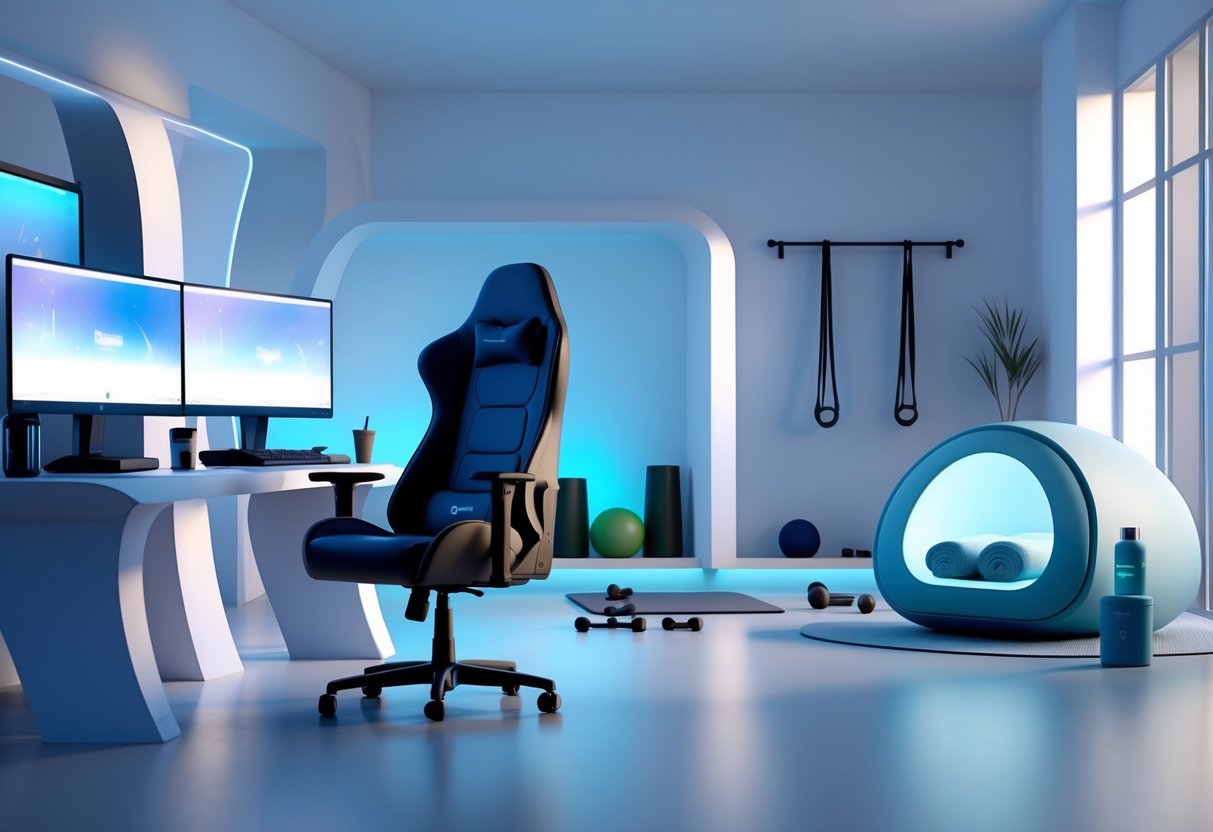
Getting enough sleep does more for your game than any fancy gear. Recovery isn’t just about feeling rested—it can make or break your reaction time and focus during those clutch moments.
Sleep Optimisation for Gamers
You need 7-9 hours of good sleep every night if you want to compete at your best. No shortcuts here.
Your brain sorts out everything you practiced while you sleep. Skip rest, and your muscle memory and decision-making take a nosedive.
Stick to a regular sleep schedule—even on weekends. Going to bed and waking up at the same time helps your body run smoother.
Make your room gamer-friendly for sleep:
- Blackout curtains to block out lights
- Blue light glasses two hours before bed
- Keep the room cool—16-19°C is ideal
- Leave your phone out of the room or at least on airplane mode
Late-night gaming is part of the culture, but the best teams enforce strict sleep times.
Cut off caffeine after 2 PM, and ditch energy drinks at least six hours before bed. They stick around in your system longer than you think.
The Role of Rest in Focus
You can’t focus if you’re exhausted. In esports, mental stamina matters more than physical.
Sleep boosts your reaction speed. Just losing two hours can slow you down by 50 milliseconds—enough to lose a key fight.
Break up your gaming with real rests. That 20-20-20 rule? It works: every 20 minutes, look at something 20 feet away for 20 seconds.
Rest days matter. The pros step away from their main game now and then to dodge burnout.
Active recovery helps too:
- Light exercise or a walk
- Play a different kind of game
- Try meditation or breathing exercises
- Hang out with friends, no screens
After about 90 minutes of intense gaming, your focus drops. Plan your training around these cycles instead of forcing endless marathons.
Designing Your Esports Exercise Routine
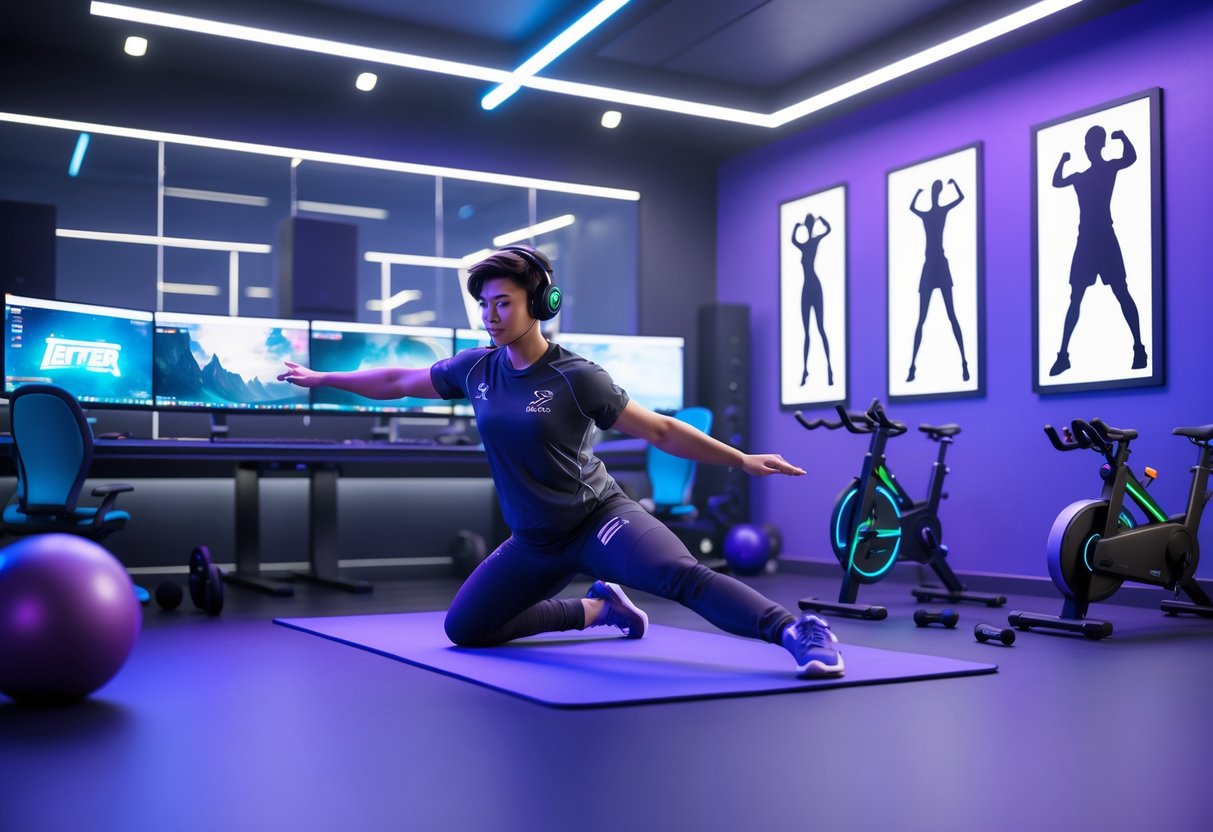
Balancing gaming with the right exercise keeps you sharp and injury-free. If you follow a weekly plan, you’ll stay at peak performance and avoid the aches that come from nonstop competitive play.
Structuring Your Week
Pro teams don’t wing it—they plan. Excel Esports, for example, splits their week into stretching, cardio, and resistance training.
Daily stretching (15-20 minutes) is non-negotiable. Focus on your back, neck, and wrists—those are the gamer hotspots for pain.
Cardio happens 2-3 times a week, usually for 45 minutes. Running, cycling, or even team sports keep it interesting and build up your stamina for tournaments.
Resistance training? Twice a week for 30-45 minutes. Stick to bodyweight moves like push-ups, planks, and wall sits. A strong core and upper body help you sit better and longer.
Fit workouts around your gaming. Mornings can energize you; evenings help you wind down after a tough day.
Dial back the intensity during tournament weeks, but don’t skip your daily stretching.
Incorporating Rest Days
Rest days are crucial—they let your body and mind recover. Skipping them just sets you up for burnout.
Plan for 1-2 full rest days every week with no intense workouts. Gentle stretching or a short walk still help.
Active recovery beats total rest. Move a little, stretch, or do something fun away from screens. It keeps your blood moving and your brain happy.
Pay attention to how you feel. If you’re wiped out or your game slips, you probably need more rest.
If you skip rest days, you risk injuries and mental fatigue—not worth it.
Before big competitions, take a full rest day. You’ll show up fresh and focused.
Mental Wellness and Cognitive Performance
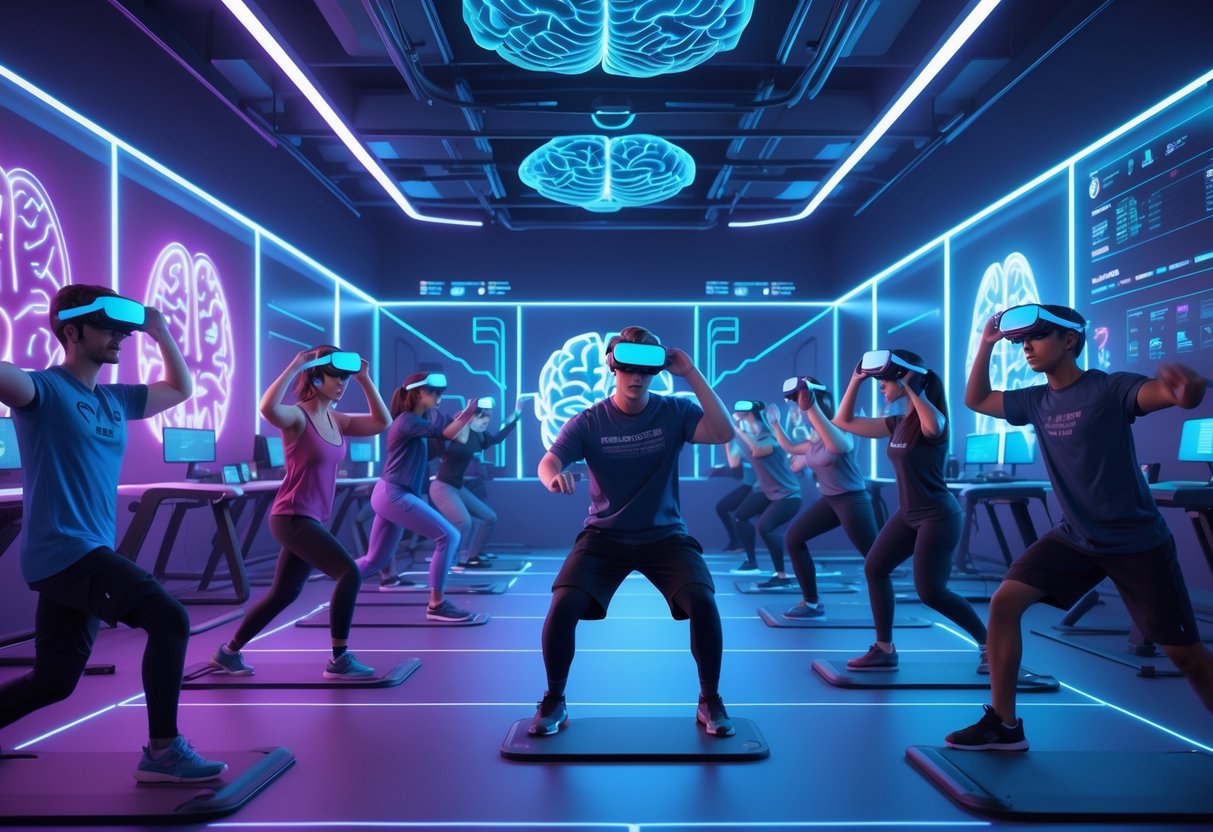
Exercise isn’t just about muscles—it rewires your brain. Physical activity can speed up your reactions, sharpen your decisions, and help you handle the stress that comes with serious gaming. Why not give it a shot?
Strategies for Focus and Concentration
Your brain doesn’t treat gaming any differently than other tough mental tasks. If you’re physically fit, blood gets to your brain more easily. That means you process things faster and keep your focus sharp, even during long sessions.
Cardiovascular exercise really helps here. Running, cycling, or just brisk walking for 20-30 minutes releases chemicals that boost your attention. Plenty of pro players swear by cardio—they say it clears their head and helps them think better.
Try a simple routine:
- Morning cardio: 15-20 minutes before you start gaming
- Movement breaks: Take a 5-minute walk every hour during practice
- Active recovery: Do light workouts on your off days
Hand-eye coordination gets a boost from physical activity too. When you improve your overall fitness, your fine motor skills get sharper. That means better mouse control and more precise keyboard moves.
Timing makes a difference. If you do light exercise before gaming, you’ll probably feel more alert. Save the intense workouts for after practice—otherwise, you might feel too tired to play your best.
Managing Stress and Performance Pressure
Esports competition stress can hit like a truck. Your heart pounds during clutch moments, just like it does for traditional athletes. The catch? Most gamers don’t have the physical base to handle this kind of stress.
Regular exercise works as stress insurance. If you’re fit, your body handles cortisol (that pesky stress hormone) way better. You stay calmer under pressure and keep clear thinking when it matters most.
Mental resilience grows when you tackle physical challenges. When you push yourself in the gym, tournament pressure doesn’t feel quite so overwhelming. Your brain learns to focus even when your body is under stress.
Some quick stress management tricks:
- Deep breathing: Breathe in for 4 counts, out for 6, between matches
- Progressive muscle relaxation: Tense and release muscle groups
- Visualization: Mentally rehearse tough game scenarios
Teams are catching up. Pro organizations hire psychologists and fitness coaches now. They’ve noticed players with stronger physical and mental health perform more consistently during long tournaments.
Heads up: Don’t do intense exercise right before a big match. Stick to light movement or stretching so you stay loose but not wiped out.
Customising Training for Specific Esports Titles
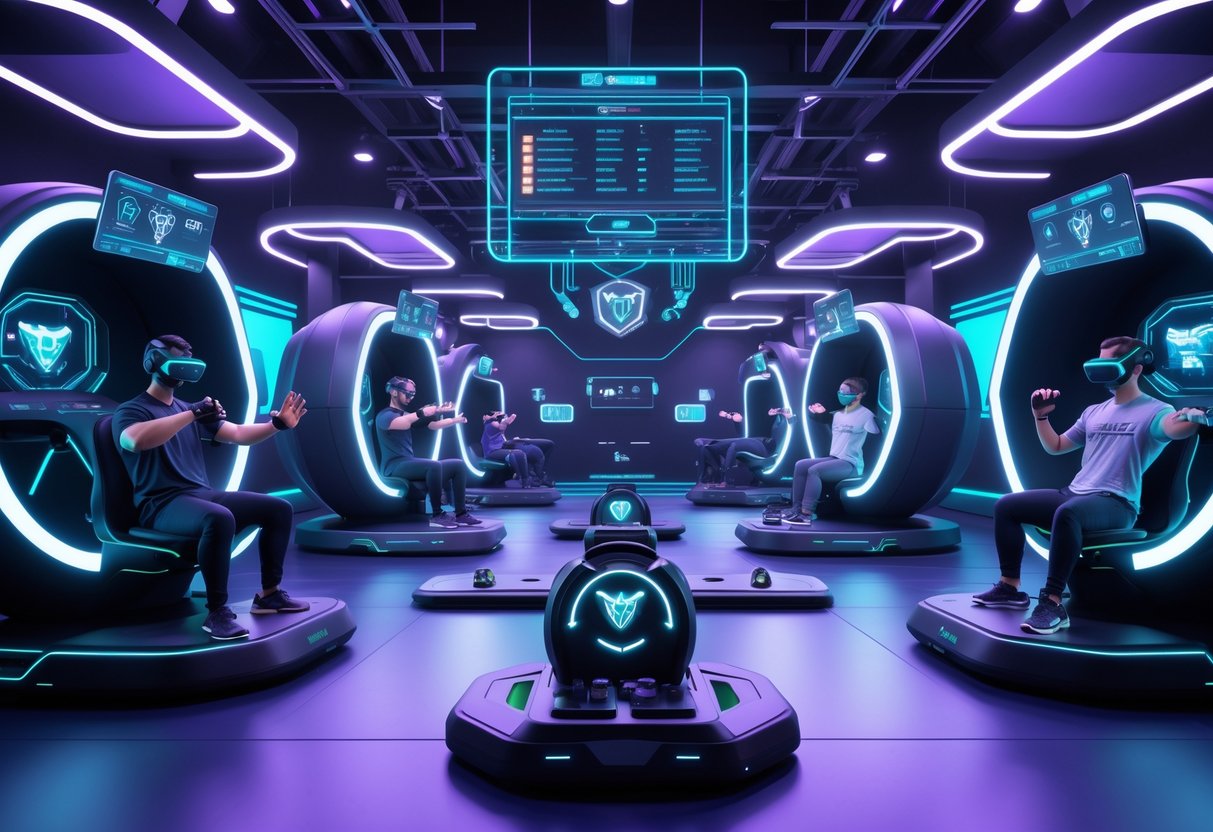
Different esports games need different training methods. MOBA players focus on map awareness and teamwork. RTS players, on the other hand, need to master micro-management and build orders.
Routines for League of Legends and MOBA Games
MOBA games like League of Legends call for unique physical and mental training. You’ve got to react quickly and think several steps ahead.
Physical Training Priorities:
- Wrist and finger flexibility exercises
- Eye movement drills for map awareness
- Core strengthening for those long gaming sessions
Try a 10-minute warm-up before you practice. Focus on finger stretches and wrist rotations to avoid strain during long matches.
Most League of Legends pros spend 2-3 hours daily on mechanical practice. They’ll work on last-hitting minions, landing skill shots, and mastering champion combos.
Mental Training Elements:
- Map awareness drills in custom games
- Decision-making scenarios with time pressure
- Communication exercises with teammates
Practice vision control for 30 minutes a day. Set up custom games to drill ward placement and jungle tracking—no pressure, just pure practice.
Pro MOBA players use replay analysis all the time. Spend 45 minutes reviewing your gameplay, and focus on your positioning and missed chances in team fights.
Training for RTS Games Like StarCraft II
RTS games demand the fastest actions per minute (APM) in esports. StarCraft II players need super precise finger control and lightning-fast decisions.
Micro-Management Training:
- Finger dexterity exercises (think piano drills)
- Unit control practice in game modes
- Hotkey muscle memory work
StarCraft II pros use finger exercises similar to what pianists do. Try running scales on your keyboard for 15 minutes before you play to boost finger independence.
Spend 60-90 minutes each day practicing build orders. Nailing standard builds lays the groundwork for tournament play.
Strategic Training Components:
- Economic management drills
- Multi-tasking across game areas
- Building counter-strategies for specific opponents
Use build order trainers and timing attack scenarios. These help you get the timing just right for top-level RTS play.
Long matches really test your mental stamina. Practice 45-minute focused sessions (no breaks!) to build up the concentration you’ll need for best-of-seven series.
Balancing Practice, Competition, and Wellbeing
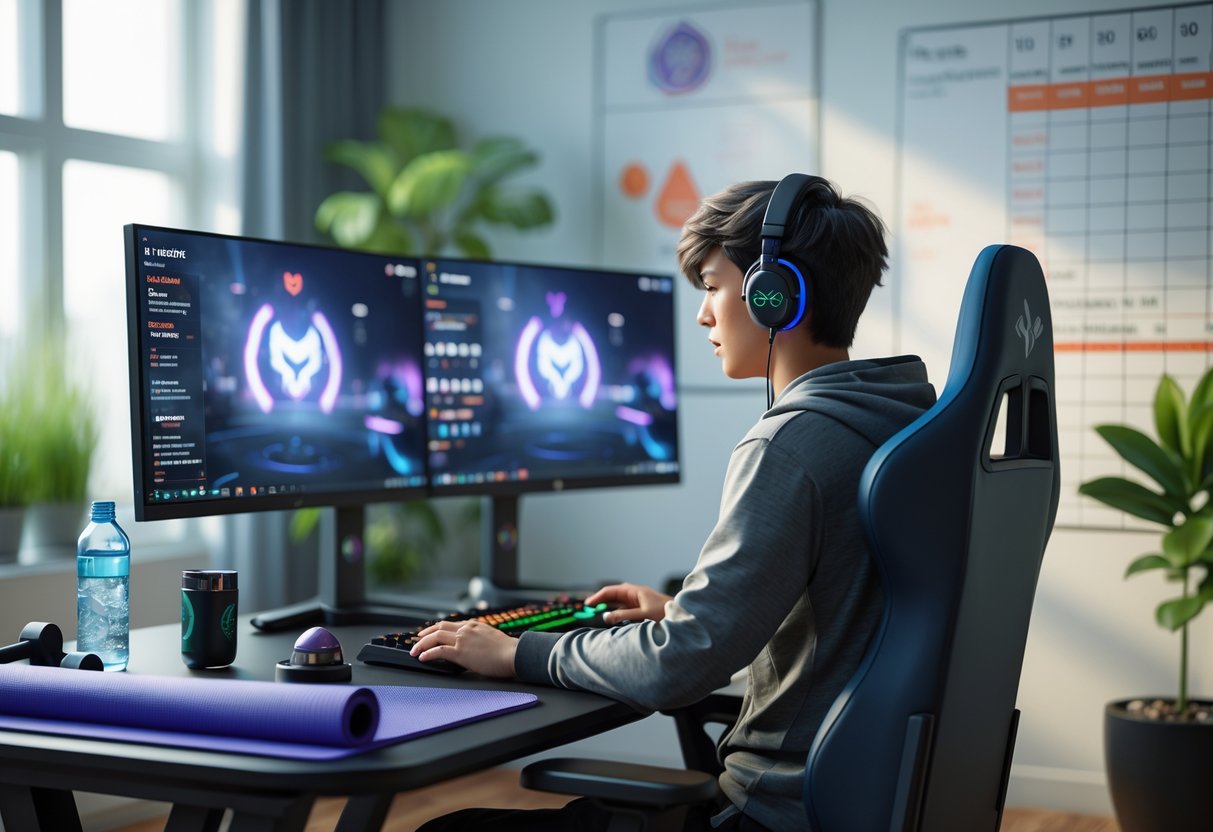
The smartest esports athletes know that grinding 16 hours a day is a fast track to burnout. Most pros now set aside about an hour a day for physical exercise, along with five hours of practice. It turns out, sustainable training beats endless grinding every time.
Avoiding Overtraining
Overtraining sneaks up when you push past your limits without enough rest. Some players still think more practice always means better results, but that’s just not true.
Watch for these overtraining signs:
- You play worse even though you’re practicing more
- You feel tired or cranky all the time
- You get headaches or eye strain
- You lose your motivation for gaming
Pro teams see these problems now. Top organizations limit high-intensity practice to keep players fresh for big tournaments.
Recovery strategies that actually help:
- Take full rest days—no competitive games at all
- Use active recovery (light exercise or casual games)
- Schedule breaks during long practice blocks
- Check in on your mood and performance every week
Try the 20-20-20 rule: every 20 minutes, look at something 20 feet away for 20 seconds. Your eyes will thank you after those marathon sessions.
Most pros follow strict schedules instead of grinding non-stop. They mix up intense practice, skill building, and full rest.
Creating a Sustainable Lifestyle
If you want a real career in esports, treat it like any other serious sport. That means balancing training, competition, and your own wellbeing so you can stick around for the long haul.
Daily routine basics:
- Sleep: 7-9 hours a night for quick reactions
- Exercise: 30 minutes of activity most days
- Nutrition: Eat regular meals, not just snacks during matches
- Social time: Keep up with friends outside of gaming
Pro esports athletes often work with fitness coaches and nutrition experts. They know physical health matters for in-game performance.
Weekly schedule ideas:
- 5-6 hours of serious practice a day
- Cardio exercise 2-3 days a week
- Strength training sessions in the mix
- Plan for social activities or hobbies
Before big tournaments, players usually dial back the practice intensity. This helps them avoid mental burnout.
Quick tip: Track your energy and performance for two weeks. Notice how your habits affect your game. This helps you figure out what balance works best for you.
The smartest players see wellbeing as part of their edge—not a distraction from practice.
Frequently Asked Questions
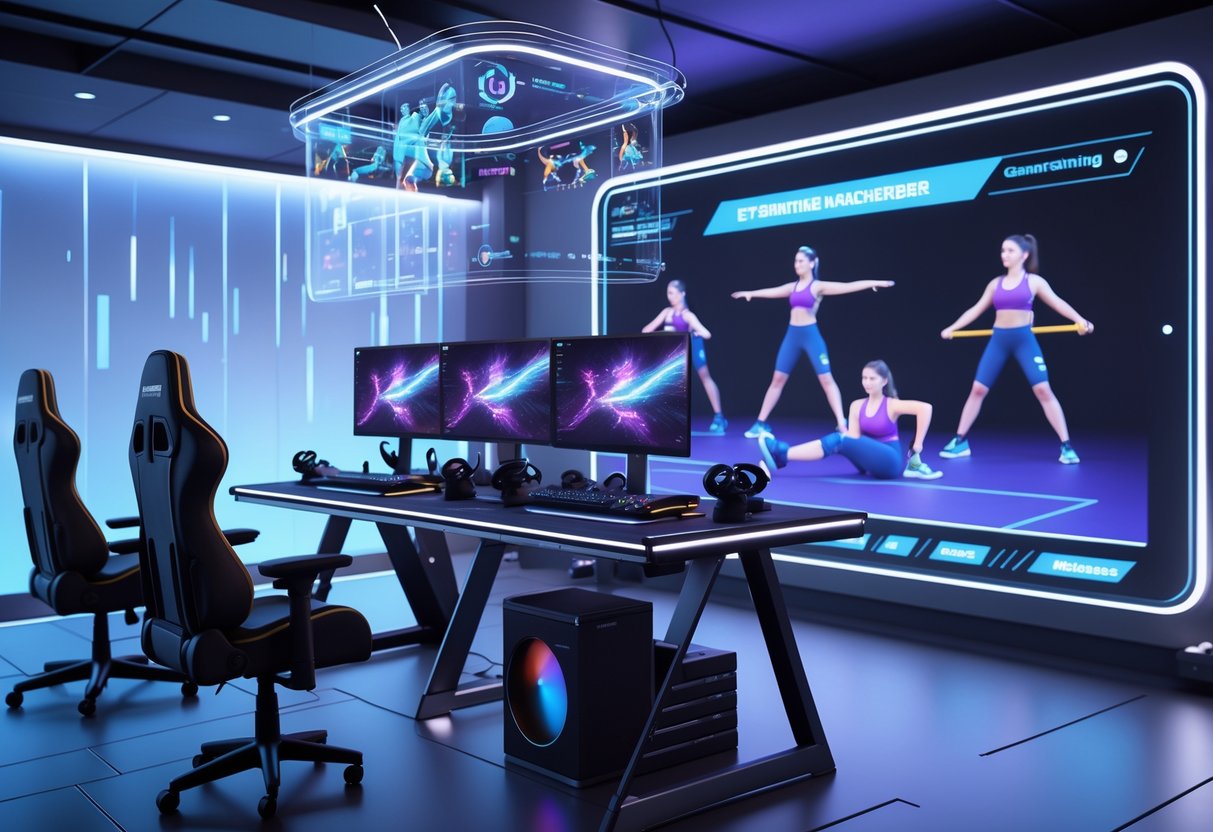
Good exercise routines help esports players dodge injuries, boost reaction times, and stay focused during those long sessions. Here’s what most people want to know about building effective fitness habits.
What are some effective warm-up exercises for competitive gaming?
Start with dynamic wrist circles and finger stretches—these prep your hands for fast, precise moves. Do 10 gentle rotations each way.
Neck rolls help with that forward head posture you get from staring at screens. Try 5 slow circles in each direction.
Light shoulder shrugs and arm swings wake up your upper body muscles. If you want, add 30 seconds of easy jumping jacks to get your blood pumping.
Quick tip: Just 3 minutes of wrist, neck, and shoulder moves before you play makes a difference.
How can physical exercise improve esports performance?
Regular cardio makes your reaction time and thinking quicker. Studies show gamers who exercise actually make decisions faster.
Strength training helps your posture and cuts down on fatigue during long matches. If you sit up straighter, your neck and back won’t ache as much.
Exercise also keeps stress hormones in check. Even a short 20-minute workout can keep you calm during tense moments.
That’s why more pro teams are hiring fitness coaches—small physical gains often mean better in-game results.
Can you suggest a weekly exercise plan tailored for esports players?
Monday and Thursday: Do 30 minutes of cardio, then some core work. Planks and dead bugs will help support your back.
Tuesday and Friday: Focus on upper body strength with resistance bands or light weights. Hit your shoulders, upper back, and arms.
Wednesday: Try gentle yoga or stretching for active recovery. It’ll help with flexibility and stress.
Weekend: Pick a longer activity you enjoy—walking, cycling, swimming, whatever works. Shoot for 45-60 minutes of movement.
What types of stretches should be included in an esports player’s routine?
Neck stretches help with screen-time posture. Hold gentle side bends for 15-20 seconds each way.
Wrist and forearm stretches keep repetitive strain injuries away. Gently pull your fingers back with your arm straight.
Hip flexor stretches undo the tightness from sitting too long. A simple lunge for 30 seconds per side does the trick.
Upper back stretches open up your shoulders. Clasp your hands behind your back and lift gently.
Are there any specific strength training exercises beneficial for gamers?
Rows and reverse flies hit the upper back muscles that fight slouching. Resistance bands work if you don’t have weights.
Core moves like planks and bird dogs keep your spine steady during long sessions. Try 30-second holds to start.
Grip strength matters too—squeeze a stress ball or tennis ball for 10 reps.
Just a heads up: start light and focus on good form, not heavy weights.
How often should esports athletes take breaks to exercise during training sessions?
Try taking a 6-minute active break after every hour of gaming. Most people find this keeps their focus sharp and helps avoid physical strain.
Use these breaks for light movement—maybe walk around, stretch a bit, or do a few bodyweight exercises. Sometimes, just standing up and moving your arms feels surprisingly good.
If you’re getting ready for a tournament, you might want to take a 10-minute break every 90 minutes. That gives you enough time for a deeper stretch.
Some players swear by shorter, 2-3 minute breaks every half hour, especially during those intense practice sessions. Honestly, it comes down to what keeps your mind clear and your body comfortable.

